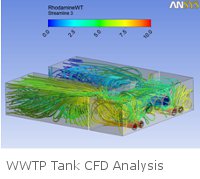Numerical Modelling
 Manly Hydraulics Laboratory (MHL) has extensive experience in the investigation of effects of water flows in the environment and on structures. In the current climate, understanding flooding characteristics, estuarine and other system processes through numerical modelling can be extremely important in making management decisions.
Manly Hydraulics Laboratory (MHL) has extensive experience in the investigation of effects of water flows in the environment and on structures. In the current climate, understanding flooding characteristics, estuarine and other system processes through numerical modelling can be extremely important in making management decisions.
MHL has a broad collection of numerical models backed by extensive experience in their application to flooding and water circulation processes in rivers, estuaries, oceans, lakes and hydraulic structures. The key numerical modelling project types carried out at MHL include:

- Flood and Hydrologic Modelling (TUFLOW, MIKE Flood, WBNM, RMA)
- Hydrodynamic River, Estuary and Coastal Modelling (RMA, MIKE, REFDIF, SWAN, SBEACH)
- Computational Fluid Dynamics (CFD) Modelling
Flood And Hydrologic Modelling
MHL is experienced in the use of numerical models to investigate rainfall-runoff processes and flooding. Studies have included investigation of local overland flooding in urban and rural catchments, riverine flooding, elevated ocean level and wave action flooding in coastal environments, and combinations of these types of flooding.
Hydrodynamic Modelling – Rivers, Estuaries and Coastal
MHL generally employs the RMA suite of models to investigate hydrodynamic, water quality and sedimentation processes in riverine, estuarine and coastal environments. Modelling can include 1D, 2D (laterally or depth-averaged) and 3D elements as required by the model application. Projects have included the study of:
- Estuarine processes and residence times
- Estuarine circulation and dispersion patterns
- Wetland hydraulics
- Water quality in relation to point and diffuse sources
- Salinity in response to sea level rise
- Outfall dispersion
- Sediment transport and deposition
CFD Modelling
 Computational Fluid Dynamics (CFD) allows detailed simulation of fluid flow through 2D and 3D systems and structures. MHL utilises the ANSYS CFX software to investigate hydraulic flows assisting in analysis, design and optimisation of:
Computational Fluid Dynamics (CFD) allows detailed simulation of fluid flow through 2D and 3D systems and structures. MHL utilises the ANSYS CFX software to investigate hydraulic flows assisting in analysis, design and optimisation of:
- Hydraulics Structures
- Spillways
- Intake Structures
- Fish Passage and protection
- Water and wastewater management
- Mixing in WWTPs
- Reservoir circulation including artificial mixing and water withdrawal characteristics
- Industrial Flow Procesess